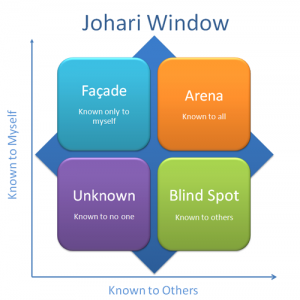

In a time when correspondence between two humans is via a computer, the need for an organization to remain open, transparent and honest is constant. In the course of their online communications, organizations have learnt to be polite and friendly but at times when things go wrong, it is natural to develop what is known as the blame culture.
If we were to try and help an organization develop a sense of openness about itself, you will have to work on the behavioral tendencies of the people who work within its portals. One way you could do this is by the Johari Window which can be a useful framework for reviewing the quality of openness in any group or organization. This is a concept that was first put together by Joseph Luft and Harry Ingham
The Johari window uses a four ‘pane’ system of dividing personal awareness into 4 categories. Our awareness on our qualities is based on what is out in the open, what is hidden, what is unknown and what is blind.
1. Some of our characteristics are pretty obvious to us as well as to those around us. This is shared knowledge and is the basis for all of our mutual dealings with one another. This is referred as “Arena”. Rest assured that all the communication that takes place in this quadrant will be fruitful and effective.
2. There are some aspects of our personality that we are well aware of, but the others we associate with have no clue about it. Referred to as the “Facade”, this pane encourages us to engage in trickery, politics and defensiveness. The larger this pane the lesser the chance of us developing truly meaningful and open relationships with others. These are our boundaries or personal side of our life that we choose to keep to ourselves and need to be respected.
3. There are often some qualities about ourselves that are pretty clear to all around us, but we somehow fail to see it ourselves. This is a “blind-spot”. This can be very self limiting because we risk exposing ourselves to weaknesses which we don’t know about and which can easily be exploited by others. We can minimize this pane by talking to our peers / managers / friends and asking them to provide us feedback from time-to-time.
4. Some will be unknown to anyone – neither to us nor to others. This is the great “Unknown” – a potential source of personal creativity and other resources which we may never have even suspected. Great insights and surprises can be experienced here.
The window panes’ size will vary, depending on the degree of trust that exists in the group or organization. So the simple conclusion you can come to is - Bigger the size of the ‘arena’ à greater the degree of trust à greater the chance of learning. When you apply this to the functioning of your organization, you will find that it will be easier to work out any issues that you may be facing.

